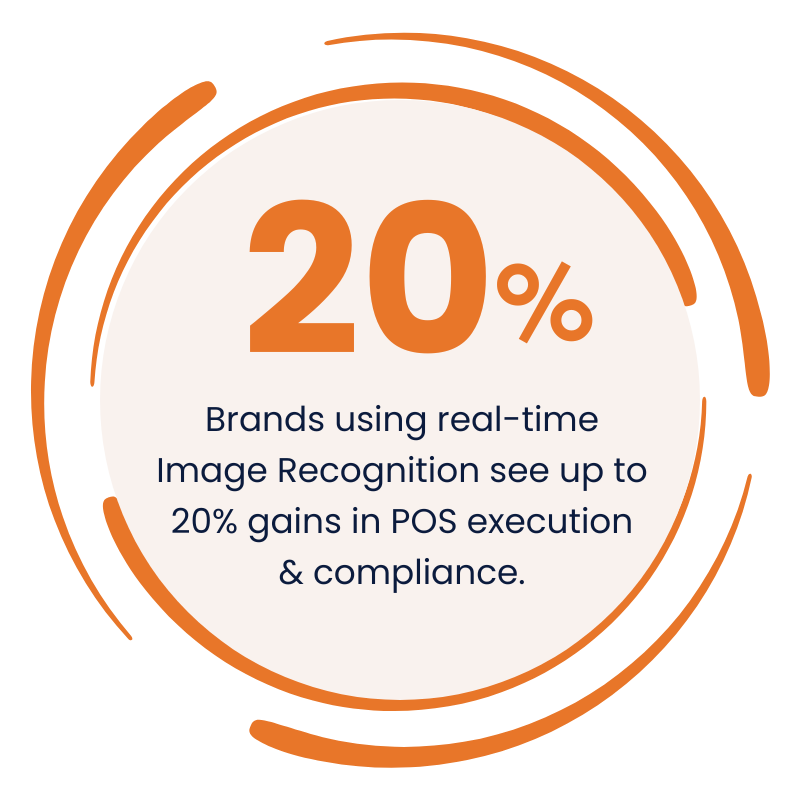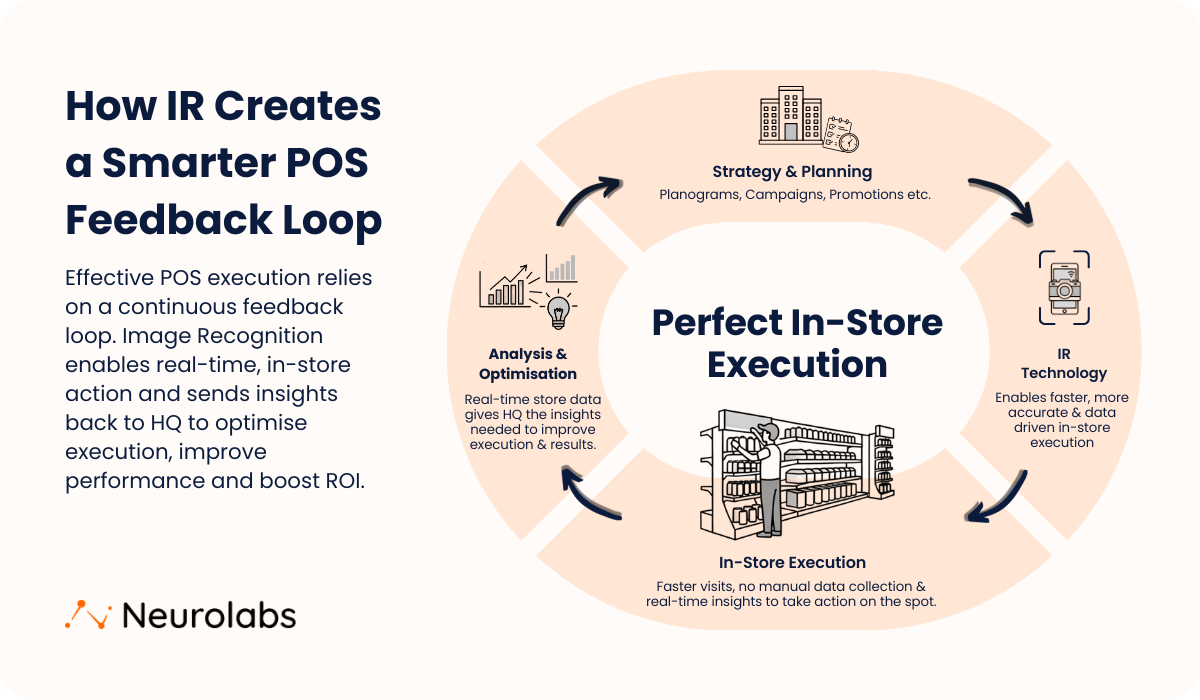Contents
POS (Point of Sale) displays are one of the most powerful levers in a CPG brand’s retail strategy but they’re also one of the hardest to track and measure. Despite their short life, changing every one to four weeks, these displays play a significant role in driving revenue and brand visibility. In an era of shrinking margins and high promotional spend, flawless execution can be a game-changer.
From trade marketing to field execution, every team plays a role in getting these displays into stores. However, a lack of real-time visibility means brands are often left guessing what’s actually happening on the store floor. Without clear execution data, it’s hard to know what’s working, what’s not and how to tie performance back to commercial impact. But that's changing. With advanced Image Recognition (IR) technology, brands can now connect the dots between display planning, execution and outcomes in real-time.

Why POS Displays Matter More Than Ever
POS displays are a staple of CPG campaigns for good reason. When done well, they grab shopper attention, accelerate product sales and support high-priority promotions. But they’re not just marketing assets, they’re a shared responsibility across multiple teams.
Even with weeks of planning and investment, execution issues still arise: displays don’t go up, pricing is unclear, promotional materials are missing, brand communication is out of sync with broader marketing campaigns, or the wrong products are stocked. These seemingly small gaps can quietly erode campaign ROI.
Even the best display strategy can fall flat without execution visibility. Unfortunately, 38% of in-store product and marketing initiatives aren’t carried out as intended. This a significant gap that leads to lost sales and wasted investment. In fact, POI research reveals that less than half of companies surveyed (46%) are fully satisfied with their promotions’ returns, a clear sign that something is broken in the execution loop.

This problem is further compounded by a lack of real-time monitoring. A staggering 26% of teams admit they don't execute any in-flight monitoring at all, and many others rely on manual, time-consuming processes that pull them away from strategic work. These delays between plan approval and store setup are common, often missing the narrow window when a campaign has the most impact. In contrast, brands using real-time Image Recognition are seeing significant uplifts in ROI on promotional execution by spotting issues early and acting fast. In some cases, brands are seeing an uplift of up to 20% in POS execution and compliance rates.
Who Owns Display Execution?
Delivering a successful POS display activation isn’t just about one team doing their job, it’s about all teams pulling in the same direction, at the same time. Execution touches nearly every part of the go-to-market team:
- Revenue Growth Management (RGM) - Defines the pricing strategy, discount levels and overall promotional mechanics.
- Marketing - Develops campaign messaging, brand positioning and creative assets for above and below-the-line channels.
- Trade Marketing - Localises materials, adapts messaging for retailers and ensures assets are fit for the in-store environment.
- Key Account Managers (KAMs) / Retail Teams - Negotiate display space, location and promotional calendars with retail partners.
- Field Sales & Merchandising Teams - Execute the plan in-store, set up displays, capture evidence and report compliance.
With so many touchpoints, even minor misalignments can impact the end result. Some of the most common issues we see include:
- A display doesn’t go up when it should, or a promo starts before displays are delivered or set up, creating a missed opportunity for the brand.
- Field teams stock the wrong product variant due to outdated briefs.
- The price level isn’t clearly communicated (or missing).
- Old or incorrect campaign materials used.
- The display visuals don’t match what the brand is pushing through ATL (Above The Line) or digital.
- Manual tracking leads to inaccurate data or missed issues.
In fact, 75% of companies agree that they are struggling to have retailer-aligned promotions executed at the store level. These gaps don’t just affect marketing execution, they impact revenue, retail relationships and ultimately brand equity.
The Visibility Gap in POS Execution
Despite the effort behind them, POS displays often suffer from a lack of real-world visibility. Traditional field audits are manual, costly, inconsistent and delayed. Even when done well, they typically capture just a snapshot, not the full picture.
As a result, key execution questions often go unanswered:
- Is the display set up in the right location?
- Is the correct signage and promo pricing visible?
- Are the required products or cases present?
- Was the campaign executed to the standard agreed with retail partners?
Without structured answers, it becomes difficult to link execution to outcomes and even harder to optimise for future campaigns.
How Image Recognition Closes the Loop
You can have the perfect display strategy on paper, the right SKUs, pricing and creative. But if you can’t see what’s happening in-store, it’s all guesswork.
That’s where Image Recognition transforms the process.
At Neurolabs, our Synthetic IR doesn’t just track presence, it turns shelf and display photos into real-time, high-precision data you can actually act on. Built using synthetic data and digital twins, it delivers field accuracy at scale, no retraining, no delays. Here’s how it strengthens display execution:
Level 1 – Presence Validation
- Confirms whether displays were deployed and where.
- Tracks display coverage across geographies or store types.
- Detects missed executions in-store, right where it matters most.
Level 2 – Standards Compliance
- Measures key execution details: number of cases, correct signage, pricing, planogram and campaign alignment.
- Flags partial setups, missing SKUs or off-brand materials, instantly.
Level 3 – Commercial Impact
- Connects execution data to sales uplift via EPOS (Electronic Point of Sale).
- Validates invoices and minimum order quantities tied to promotions (e.g. 20-case placement).
- Enables granular ROI analysis fed into Sales Ops, RGM and Marketing to optimise future campaigns with confidence.

With Synthetic IR, you’re not just auditing displays you're building a live feedback loop between trade, sales, marketing and retail. You don’t just see what happened you know what worked, what didn’t and what to fix tomorrow.
Why It Matters Across Every Team
Field Teams
- Get instant feedback from shelf photos, helping them spot and fix execution gaps in-store in the moment, where it matters most.
- Spend less time collecting data and more time engaging with retailers, selling or correcting displays that drive impact.
Trade Marketing
- Gain real-time, store-level visibility into how well displays were executed down to SKU, signage and pricing.
- Compare performance across formats, retailers and geographies to refine future activations and display designs.
RGM & Commercial
- Tie execution quality directly to sales uplift, promotional ROI and trade compliance.
- Make smarter investment decisions using real-world data, not assumptions or anecdotal feedback.
Marketing
- Understand how campaigns come to life in-store and whether the intended messaging actually makes it to the shelf.
- Use data to iterate creative strategies and validate which visuals, formats or copy resonate best with shoppers.
Sales Leadership
- Turn execution into a measurable KPIs, supporting better planning, retail negotiations and rep incentives.
- Ensure field time is being spent where it drives the most value.
Ultimately, image recognition provides a single source of truth that empowers every team to make data-driven decisions.
Looking Ahead: Close the Loop Between Strategy and Store
As retail gets more dynamic and promotion-led, execution visibility is no longer a luxury, it’s a competitive edge. Our Synthetic Image Recognition technology goes beyond basic auditing, giving you the real-time, store-level insights you need with the speed, accuracy and scale global CPGs demand.
It’s not just about whether the display went up. It’s about what it delivered and how fast you could improve it.
Want to see how IR could transform your next campaign? Talk to one of our experts today!




